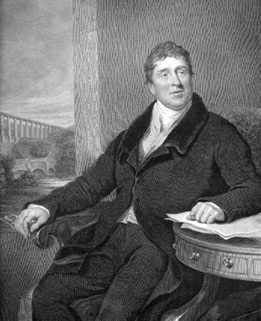| Thomas Telford  Born: 9-Aug-1757 Born: 9-Aug-1757
Birthplace: Westerkirk, Dumfries, Scotland
Died: 2-Sep-1834
Location of death: London, England
Cause of death: unspecified
Remains: Buried, Westminster Abbey, London, England
Gender: Male
Race or Ethnicity: White
Occupation: Engineer Nationality: Scotland
Executive summary: Scottish canal, bridge, and road builder British civil engineer, the son of a shepherd, and born at Westerkirk in Eskdale, Dumfriesshire, on the 9th of August 1757. From early childhood he was employed as a herd, occasionally attending the parish school of Westerkirk, where his quickness and diligence helped to make up for his lack of opportunity. On being apprenticed, at the age of fifteen, to a stonemason at Langholm, he found leisure not only to gain an acquaintance with Latin, French and German, but to gratify his literary tastes by a wide variety of reading. In his early manhood he was much given to the writing of verse: a poem of some length on Eskdale appeared in 1784 in the Poetical Museum, published at Hawick; under the signature of "Eskdale Tam" he contributed verses to Ruddiman's Weekly Magazine; and he addressed an epistle in rhyme to Robert Burns, which was published in James Currie's Life of the poet. In 1780 Telford went to Edinburgh, where he was employed in the erection of houses in the "new" town, and occupied much of his spare time in learning architectural drawing. Proceeding to London two years later, he found employment in the erection of Somerset House. Having in 1784 superintended the erection of a house for the commissioner at Portsmouth dockyard, he next repaired the castle of Sir W. Pulteney, member for Shrewsbury, who conceived such a high opinion of his talents that he got him made surveyor of public works for the county of Salop. In 1793 he was appointed engineer of the Ellesmere canal, for which he built the Chirk and Pont-y-Cysyllte aqueducts, and this work established his reputation as a canal engineer. He was consulted in 1806 by the King of Sweden regarding the construction of the Göta Canal, and, his plans having been adopted, he visited the country in 1810 to superintend some of the more important excavations. In the early years of the 19th century the question of improving the communications in the Highlands of Scotland engaged the attention of the government, and Telford was commissioned to report on the matter. In consequence of his recommendations, he was appointed engineer for the Caledonian Canal, which was begun in 1804 and forms one of the largest but by no means the most useful of his undertakings, and also for the construction of 920 miles of roads, a great part through very difficult country. Of the numerous bridges built in this line of roads mention may be specially made of that across the Tay at Dunkeld. Subsequently he was employed on the improvement of the road between Carlisle and Glasgow, which was undertaken as a result of a parliamentary inquiry in 1814, and he was then entrusted with the execution of another scheme, of equal magnitude and importance with that in the Highlands of Scotland, for a system of roads through the more inaccessible parts of Wales, which involved the erection of the magnificent suspension bridge across the Menai Straits, begun in 1820, and the Conway Bridge, begun in 1822. While his fame rests chiefly on his road and canal engineering, and the erection of the numerous bridges and aqueducts which this involved, he also did good work in harbor construction. The fisheries and industries of Scotland benefited by the improvements he effected at many of the harbors on the east coast; he constructed the St. Katherine's Docks, London (finished in 1828); and his last piece of professional work was a plan for the improvement of Dover harbor. Other achievements of his later years were the drainage of the north level of the eastern Fen district, an area of 48,000 acres, and erection of the Dean Bridge, Edinburgh, and of the Broomielaw Bridge, Glasgow. He died on the 2nd of September 1834 in London, and was buried in Westminster Abbey.
Telford was never married. For twenty-one years he lived at the Salopian coffee-house, afterwards the Ship Hotel, Charing Cross, from where he removed to 24 Abingdon Street. He was a fellow of the Royal Societies of London and of Edinburgh, and was annually elected president of the Institution of Civil Engineers from its foundation. He received the Swedish order of knighthood of Gustavus Vasa.
Royal Society
Requires Flash 7+ and Javascript.
Do you know something we don't?
Submit a correction or make a comment about this profile
Copyright ©2019 Soylent Communications
|